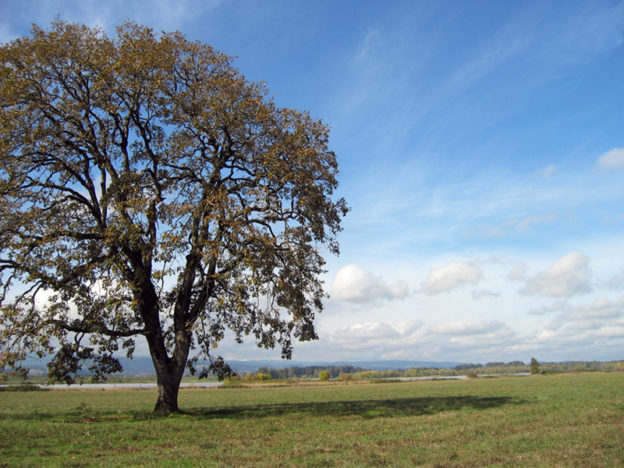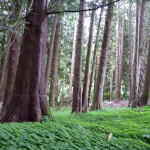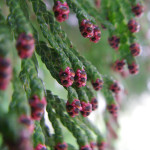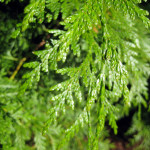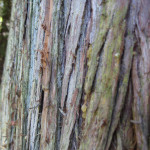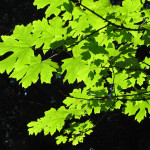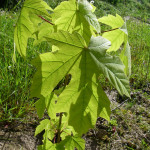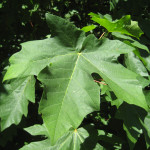Quercus garryana
The iconic Quercus garryana, also known as Garry oak and Oregon white oak, is a drought tolerant tree that can also tolerate prolonged seasonal flooding. It can often grow on sites that are too dry for other tree species. These slow-growing trees are smaller at maturity than many Pacific Northwest trees, growing eventually to a maximum size of 65-80 ft tall and wide. They have deep tap roots and widely spreading roots, making them resistant to wind-throw. Mature trees growing in open areas develop broad oval crowns, making them excellent shade trees.
The leaves are deciduous, 3-6″ long and 2-5″ broad, with 7-9 deep lobes on each side. The flowers are catkins, and the fruits are small acorns about 1″ long with shallow, scaly cups.
Over 200 species of wildlife benefit from Oregon white oaks, including pollinators such as Fender’s blue, Taylor’s checkerspot, Mardon skipper, Islad marble, and the Oregon silverspot. The Oregon white oak is also the only known food for the caterpillars of Propertius duskywing butterflies and a leaf-mining moth. Deer, bear, raccoons, squirrels, and many small mammals eat the acorns, as do wild turkeys, band-tailed pigeons, woodpeckers, jays, and others.
Oregon white oaks also have significant cultural value for many Native tribes. For all these reasons, Oregon white oaks and their associated prairie habitats are the focus of many regional conservation efforts.
- Oregon white oak (Quercus garryana) has thick, fire-resistant bark. Younger trees are more vulnerable.
- Light Requirements: Full Sun
- Water Requirements: Dry, Moist
- Ease of Growing: Moderate
- Growth Rate: Slow
- Spreads: No
- Wildlife Support: Pest-eating Insects, Birds or Mammals
- Fire-resistant: Yes
- Edible: No
- Mature Height: 25-70ft
- Mature Width:30-60ft
Western Redcedar
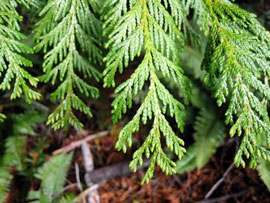
Thuja plicata
Western redcedar (Thuja plicata) is a large evergreen conifer treasured not only for its beauty, but also its wildlife value and cultural significance going back to time immemorial.
Mature Western redcedars can get 115 – 230 feet tall. The flat, elegant sprays of foliage makes the tree look like it is draped with lace, especially when dusted with frost or snow. The cones are slender with overlapping scales. This tree is actually part of the cypress family, and not a true cedar (just like Douglas-fir is not a true fir).
Western redcedars make excellent wildlife habitat, providing food and shelter for many species. Rosners hairstreak butterflies are only found in association with this tree, as they depend on it for reproduction and food for their young. Large and small mammals feed on the leaves and inner bark for most of the year; squirrels and other rodents use its shredded bark for winter nests; and many birds and small mammals find shelter and nest sites in red cedar cavities.
Western redcedar is a iconic tree of the Pacific Northwest. If you have a shady, moist spot large enough for it to thrive, this is a beautiful and valuable addition to any forested landscape.
- Light Requirements: Full Sun, Part Shade, Full Shade
- Water Requirements: Moist, Seasonally Wet
- Ease of Growing: Easy to grow
- Growth Rate: Moderate
- Spreads: No
- Wildlife Support: Birds or Mammals
- Fire-resistant: No
- Edible: No
- Mature Height: 100-200ft
- Mature Width:30ft
Western Hemlock

Tsuga heterophylla
Western hemlock (Tsuga heterophylla) is the state tree of Washington, and the largest species of hemlock, growing up to 200′ tall with a trunk diameter of up to 4′. It makes a beautiful addition to any property where it has room to grow.
Western hemlocks grow into a narrow, upright, somewhat ragged cone as they grow, with very top of the tree typically drooping over just a little bit. The needles are short and flat, averaging less than 1″ long. The small round cones dangle from the branches and have long, thin, flexible scales. The bark is thin, brown, and furrowed in texture.
This tree is an important source of food for many birds and mammals. Yellow-bellied sapsuckers nest in the tree’s cavities, and barred owls prefer dense stands of Western hemlock. Flying squirrels and other small mammals nest in hemlocks, and many animals browse the inner bark and young needles and take shelter in the dense foliage.
Western hemlock is a very shade-tolerant tree, with young plants able to grow under a closed canopy of fast-growing, shade-intolerant conifers such as Douglas-fir. Disturbances like fire or logging open up sunny areas where new generations of Douglas-fir and other sun-loving seedlings can survive, but without that disturbance, hemlocks end up dominating the canopy…and Western hemlocks can live up to 1200 years old! If you are in a forest made up of mostly large hemlocks, you know that forest has been undisturbed for a very long time.
- Light Requirements: Full Sun, Part Shade, Full Shade
- Water Requirements: Dry, Moist
- Ease of Growing: Easy to grow
- Growth Rate: Fast
- Spreads: No
- Wildlife Support: Pest-eating Insects, Birds or Mammals
- Fire-resistant: No
- Edible: No
- Mature Height: 120-200
- Mature Width:30-40ft
Grand Fir

Abies grandis
Grand fir (Abies grandis) is a shade tolerant, slow-growing evergreen tree with short, dense branches. It can get quite tall in the wild, reaching 250 feet in height and with a trunk diameter of up to 6 feet.
The glossy dark green leaves are needle-like, 3-6 cm long, and extend flat out from the branch on either side. The 6-12 cm cones do not fall to the ground whole, but disintegrate on the tree and release their seeds about 6 months after pollination.
Grand fir is an important wildlife tree. The California tortoiseshell butterfly feeds on the sap and secretions from cones and needles. Grouse eat the needles, and nuthatches, chickadees, and squirrels eat the seeds. Grand firs also provide excellent cover and nesting habitat for birds and small mammals.
The foliage has an attractive tangerine-like scent, and Grand Firs are sometimes used for Christmas decoration, including as Christmas trees. It is also planted as an ornamental tree in large parks.
Grand fir needs well-drained soils and plenty of room to grow, and is an elegant addition to any landscape.
- Light Requirements: Full Sun, Part Shade, Full Shade
- Water Requirements: Moist, Seasonally Wet
- Ease of Growing: Easy to grow
- Growth Rate: Moderate
- Spreads: No
- Wildlife Support: Hummingbirds, Pest-eating Insects, Birds or Mammals
- Fire-resistant: No
- Edible: No
- Mature Height: 200ft
- Mature Width:40ft
Noble Fir
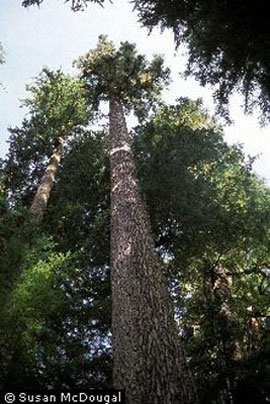
Abies procera
Noble fir (Abies procera) is native to the Cascade Range and Coast Range mountains of northwest California, western Oregon and western Washington.
It is a large evergreen tree typically up to 40-70 m tall and 2 m trunk diameter (rarely to 89 m tall and 2.7 m diameter), with a narrow conic crown. The bark on young trees is smooth, grey, and with resin blisters, becoming red-brown, rough and fissured on old trees. The glaucous blue-green needle-like leaves are 1-3.5 cm long. They are arranged spirally on the shoot, but twisted slightly to curve up above the shoot. The cones are erect, 11-22 cm long; they do not fall to the ground intact, but instead ripen and disintegrate to release winged seeds in fall.
It is a high altitude tree, typically occurring at 300-1,500 m altitude, only rarely reaching tree line.
Uses
Noble Fir is a popular Christmas tree. The wood is used for general structural purposes and paper manufacture.
- Light Requirements: Full Sun, Part Shade
- Water Requirements: Moist
- Ease of Growing: Easy to grow
- Growth Rate: Moderate
- Spreads: No
- Wildlife Support: Birds or Mammals
- Fire-resistant: No
- Edible: No
- Mature Height: 250ft
- Mature Width:30ft
Bigleaf Maple
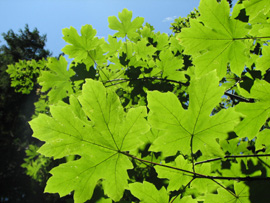
Acer macrophyllum
Acer macrophyllum (Bigleaf or Oregon Maple) is a large deciduous tree with the biggest leaves of any maple. It can grow to nearly 100 feet tall, but more commonly reaches 50-70 feet. It is native to western North America, mostly near the Pacific coast, from southernmost Alaska south to southern California. Some stands are also found inland in the foothills of the Sierra Nevada mountains of central California, and a tiny population occurs in central Idaho.
The palm-shaped leaves are typically 6-12 inches across, with five deeply-incised lobes. The flowers are produced in spring in loose dangling clusters, greenish-yellow with inconspicuous petals. The fruit is a paired, winged, V-shaped samara.
Bigleaf maple is a great wildlife tree. It provides nectar for pollinators, food for the young of tiger swallowtails and mourning cloak butterflies, and shelter for cavity-nesting birds. Mature trees are often covered with moss and ferns which are home to many invertebrates. These miniature ecosystems far above the forest floor capture and filter rain water, and provide food and nest material for birds and small mammals.
Cultivation and Uses
Maple syrup has been made from the sap of bigleaf maple trees. While the sugar concentration is about the same as in sugar maple (Acer saccharum), the flavor is somewhat different. Interest in commercially producing syrup from bigleaf maple sap has been limited.
The lumber from this tree has diverse uses, such as furniture, piano frames and salad bowls. Highly figured wood is not uncommon and is used for veneer and guitar bodies.
- Light Requirements: Full Sun, Part Shade
- Water Requirements: Dry, Moist, Seasonally Wet
- Ease of Growing: Easy to grow
- Growth Rate: Fast
- Spreads: No
- Wildlife Support: Pollinators, Hummingbirds, Pest-eating Insects, Birds or Mammals
- Fire-resistant: Yes
- Edible: Yes
- Mature Height: 90ft
- Mature Width:70ft
White Alder
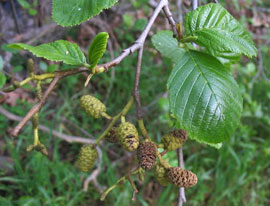
Alnus rhombifolia
Alnus rhombifolia is a medium-sized deciduous tree growing to 49-82 ft rarely to 115 ft tall, with pale gray bark, smooth on young trees, becoming scaly on old trees.
The flowers are produced in catkins. The male catkins are pendulous, yellowish, and produced in clusters of two to seven; pollination is in early spring, before the leaves emerge. The female catkins are ovoid, when mature in autumn and resemble a small conifer cone. The small winged seeds disperse through the winter, leaving the old woody, blackish ‘cones’ on the tree for up to a year after.
The White Alder is closely related to the Red Alder (Alnus rubra), differing in the leaf margins being flat, not curled under. Like other alders, it is able to fix nitrogen atmospheric nitrogen, and tolerates infertile soils.
If used domestically they should be planted well away from drainpipes, sewage pipes, and water lines, as the roots may well invade and clog the lines. These fast-growing trees often grow 3 ft. per year until 20 years of age. They are a relatively short lived species compared to other PNW native tree species.
- Light Requirements: Full Sun, Part Shade
- Water Requirements: Moist, Seasonally Wet
- Ease of Growing: Easy to grow
- Growth Rate: Fast
- Spreads: No
- Wildlife Support: Birds or Mammals
- Fire-resistant: No
- Edible: No
- Mature Height: 90ft
- Mature Width:40ft
Incense Cedar
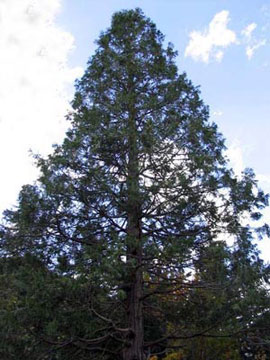
Calocedrus decurrens
Incense cedar is a conifer native from central-western Oregon through most of California. It has a distinct symmetrical shape and can get up to 90 feet tall in its native habitat.
The bark is orange-brown weathering grayish, smooth at first, weathering to grayish, fissured bark that sheds in long strips on the lower trunk on old trees. The fragrant, bright-green foliage is produced in flattened sprays with scale-like leaves. The seed cones look like the open beak of a duck. They turn orange to yellow-brown when mature about 8 months after pollination.
Many birds depend on insects that live on incense cedar, including woodpeckers, brown creepers, red-breasted nuthatches, and golden-crowned kinglets. Birds use the dense foliage for nesting in the summer and shelter in the winter. This tree is also the preferred host of a wood wasp, Syntexis libocedrii, a living fossil species which lays its eggs in the smoldering wood immediately after a forest fire.
Cultivation and Uses
The wood is the primary material for wooden pencils, because it is soft and tends to sharpen easily without forming splinters. It is also a popular ornamental tree, valued for its drought tolerance. In cool summer climates (such as in Washington, British Columbia, etc.), incense cedar tends to grow narrower than in the wild, making it a good choice for large hedges and screens.
- Light Requirements: Full Sun
- Water Requirements: Dry
- Ease of Growing: Easy to grow
- Growth Rate: Slow
- Spreads: No
- Wildlife Support: Birds or Mammals
- Fire-resistant: No
- Edible: No
- Mature Height: 100-150ft
- Mature Width:30ft

